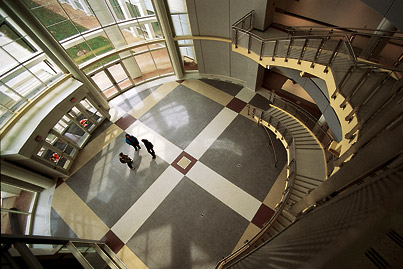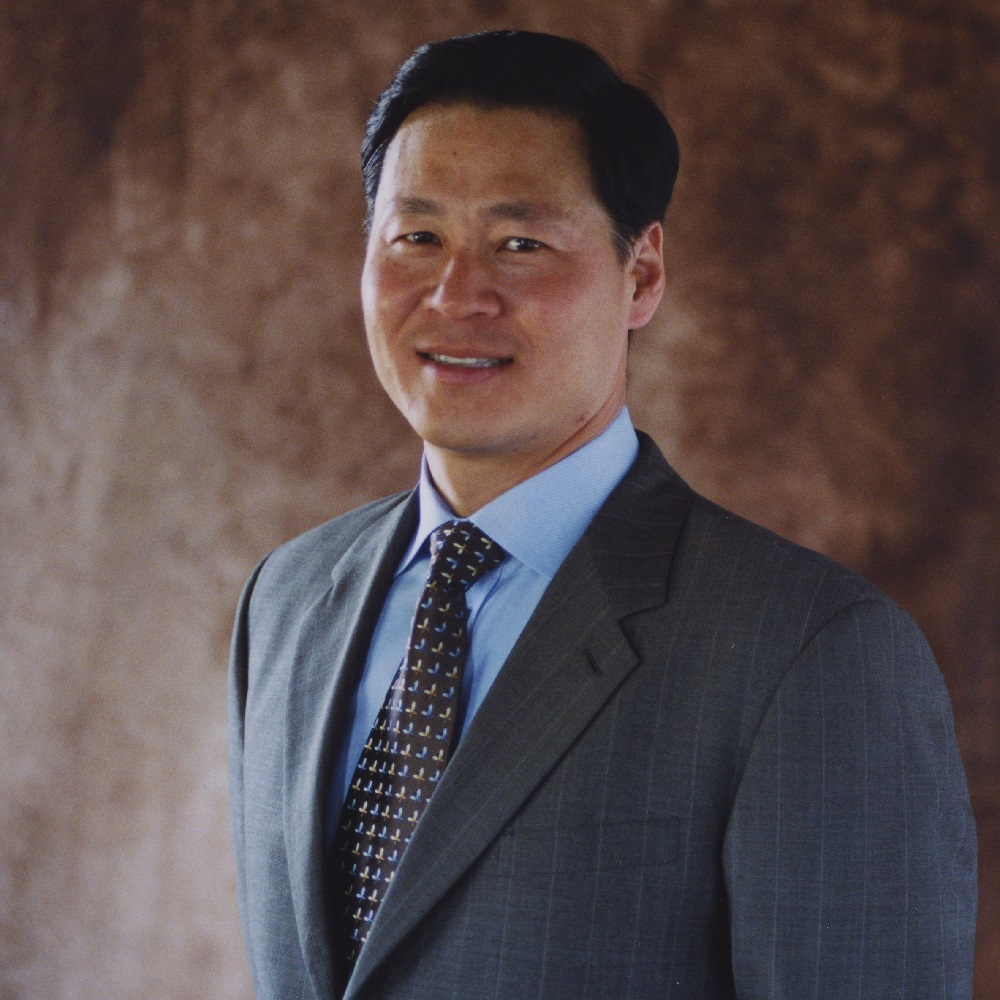The Kim Building not only houses engineering labs but is an engineering laboratory in itself. Here, students can learn about civil and environmental engineering, control systems, and construction. The interior design features exposed columns and beams, a glass-enclosed elevator shaft, windows with a variety of glazings, two types of bridges, visible color-coded pipes, and visible heating and air ducts. Students can take measurements, perform tests, control heating and cooling, and experience firsthand the concepts they learn in textbooks.
The Center for Advanced Transportation Technology Laboratory (CATT Lab) was created in order to respond to the significant changes brought about by the increasing use of advanced technologies in the transportation and homeland security field. A permanent staff of ITS professionals, affiliated faculty of the Department of Civil and Environmental Engineering, and more than 50 undergraduate and graduate students support cutting edge research in the areas of ITS technology, systems and software design, serious games, data fusion, data visualization, incident management, and user interface design. CATT Lab works directly with state and local governments, federal agencies, private industry, and the department of homeland security to develop leading edge transportation and software systems. This multi-disciplinary research facility includes students and full-time faculty from civil, mechanical, electrical, and computer engineering along with geography, art, telecommunications, computer science, and digital entertainment departments.
The Nano and Micro Fabrication Laboratory (FabLab) is a Class 1000 research cleanroom. The lab supports research and development programs in nano science and technology, micro-electromechanical systems, semiconductors, materials and devices for electronics, bioscience and bioengineering, and sensor/actuator systems. There are three separate clean rooms in FabLab covering a total area of approximately 10,000 square feet. The largest and cleanest lab is the Research Clean Room, a 6,600 square foot, Class 1000 laboratory. The rest of the lab space is divided among the Teaching Lab, the Exploratory Lab, and the SEM Room.The cutting-edge facility and equipment are open to users from the University of Maryland, area companies, other universities, and government labs.
This is a state-of-the-art characterization and research facility aimed at understanding the structure of materials. Researchers investigating organic and inorganic materials will have at their fingertips resources that reveal unique properties of materials with resolution previously unattainable. Within this lab, it will be possible to reveal even the nanostructure of organic and inorganic materials using ultra-high resolution electron microscopes. New types of imaging techniques will be available through probes using x-rays, monochromatic photons, magnetic fields, and piezoelectric forces. These probes provide researchers with unique analytical techniques to determine structure-property relationships and develop a new generation of materials with both electronic and mechanical functionality.
This laboratory focuses on nanoscale characterization of materials and structures generated in Maryland NanoCenter research laboratories or in the FabLab complex. It features high resolution transmission electron microscopy, secondary electron microscopy, scanning Auger microscopy, and scanning probe techniques for atomic- and nano-scale characterization. It is located in a section of the Kim Building designed for low vibration so that best possible spatial resolution can be achieved from the instruments there. The Nanoscale Imaging, Spectroscopy, and Properties Laboratory is adjacent to and integrated with the W. M. Keck Foundation Laboratory for Combinatorial Nanosynthesis and Multiscale Characterization.
The Keck Laboratory is a centerpiece for pioneering research. It extends campus strengths in combinatorial materials science, scanning nanoprobes, and highly controlled materials synthesis into the nanoscale domain, enabling fundamentally new insights into the behavior of materials at the nanoscale. The Keck Lab has unprecedented capabilities for the rapid exploration of advanced complex smart materials and memory devices, as well as systematic investigation of their physical mechanisms.
This lab focuses on optical information technology and systems with an emphasis on optoelectronic devices, nanostructured photonic materials, monolithic and hybrid integration technologies, modules, and optoelectronic packaging and systems. Equipment includes a 12.5 Gb/s bit-error-rate tester, optical spectrum analyzers, ultra-short optical pulse generation, a streak camera, WDM lasers on an ITU grid, a Newport auto-align system, an HP communication analyzer, high-speed detectors, a lightwave signal analyzer, and an optical wavelength meter.
This state-of-the-art lab conducts research into human-machine interactions and interfaces, high-definition broadcast and entertainment systems, content-based multimedia data archiving and retrieval, and wireless multimedia communications. Equipment includes high-definition display systems, a sound room with high-quality, surround-sound systems, high-performance graphics workstations for image- and video-processing applications, high-quality video cameras, and multi-processor workstations.
This lab houses state-of-the-art equipment for biotechnology, biochemistry, and the applications of biological science to a broad range of engineering issues. It hosts research from many of the school's departments, including chemical and biomolecular, materials, and civil and environmental engineering, and features cutting-edge information technology for data acquisition, monitoring, and process control. Capabilities include protein and DNA sequencers, near-infrared, ultraviolet, and visible spectrum spectrometry, mass spectrometry, gas chromatography, gel electrophoresis, and liquid column chromatography, including HPLC, affinity, ion-exchange, and size exclusion. The lab supports a separate module of microprocessor-controlled cell culture reactors for both aerobic and anaerobic experiments, as well as CO2 incubators, autoclaves, an environmental shaker, and a glucose analyzer. Environmental chambers for temperature and humidity control to 80 degrees below zero Celsius are available for specialized experiments, as well as laminar-flow biological hoods and other protective systems.
This lab supports the school's expanding research into applying electronics, sensor systems, and information technology to traffic management. The lab hosts a direct, fiber-optical connection to the Maryland State Highway Administration's operations control center at BWI Airport, feeding real-time traffic information to computer simulation and analysis systems on campus. It also includes large-screen imaging for traffic monitoring, network simulation, and incident management.
This state-of-the-art complex is used for developing and testing small satellites, shuttle or space station payloads, and other space systems. The main facility houses two assembly and checkout bays for the parallel development of space projects. Around the perimeter will be advanced development facilities, including rapid prototyping fabricators, vibration test stands, and a thermal vacuum chamber. A dedicated electronics fabrication and test facility and a bonded storage room for maintaining control and tracking on spacecraft components adjoin the assembly bays area. A large overhead door provides direct access for shipping the completed spacecraft to the launch site.
The Hybrid-System Integration and Simulation Laboratory (HSIS Lab) is a cluster of several experimental and computational infrastructures for interrelated research thrusts in human-system integration. The goals of HSIS Lab are to advance the design, operation, performance monitoring, and performance assessment of complex hybrid systems (human-software-hardware interaction). Behavioral and physiological monitoring tools are used to assess human stress during the performance of tasks that require varying levels of mental workload. These tasks are simulated using a Virtual Reality CAVE and large interactive screens. The collected data informs the design of interfaces and technologies that reduce user cognitive load and improve human performance in safety-critical environments, such as hospitals, nuclear power plant control rooms, and airplane cockpits.
This lab supports undergraduate and graduate students in controls-related courses throughout the school. Experimental stations will feature personal computers, data-acquisition boards and conditioning modules, signal generators and oscilloscopes. Each station hosts a series of physical experiments from motion control to fluids transport, illustrating common phenomena that complicate control design such as transport delay, instability, nonlinearity, resonance, and saturation.
For advanced student projects, there will be a microcontroller development station and a high-speed, DSP-based control station. Instructors will be able to assemble an appropriate set of controls lab experiences from a collection of self-contained modules. Topics such as identification, robust design, adaptive and nonlinear control will be studied in practice.
This lab combines facilities for studying materials' mechanical, electrical, and magnetic properties. Electromagnetic-based experiments will take place within a specially designed shielded area that eliminates electronic noise and stray fields. Another area allows students to prepare samples for mechanical testing, van der Paaw electrical mobility measurements, and thin-film conductivity experiments.
This undergraduate instructional lab helps students experience the fundamental principles of fluid physics, fluid properties, and fluid behavior. Instruction possibilities include the differences between laminar and turbulent flow, the concept of frictional losses in flow networks, and the principles of multi-phase flow. The lab provides experimental capabilities for both incompressible and compressible flow.
This lab is an integrated-circuit fabrication facility used primarily to provide students with an understanding of how a silicon wafer is turned into an operating chip. Students review transistor operation and carry out the steps of integrated circuit fabrication. The effects that processing parameters have on transistor performance are examined. The facility enables hands-on learning and experimentation in the characterization of wafers and fabrication steps, oxide growth, lithography, dopant diffusion, metal deposition, and patterning.
The state-of-the-art undergraduate design labs in the Kim Building offer a complete environment to support collaborative team design, including a full complement of personal productivity tools and engineering CAD software. They are coupled to an integrated networked environment that includes Internet-based video conferencing and collaboration. The labs primarily support classroom instruction, collaborative design projects, homework and other computer-based tasks, supplementing class lectures.

